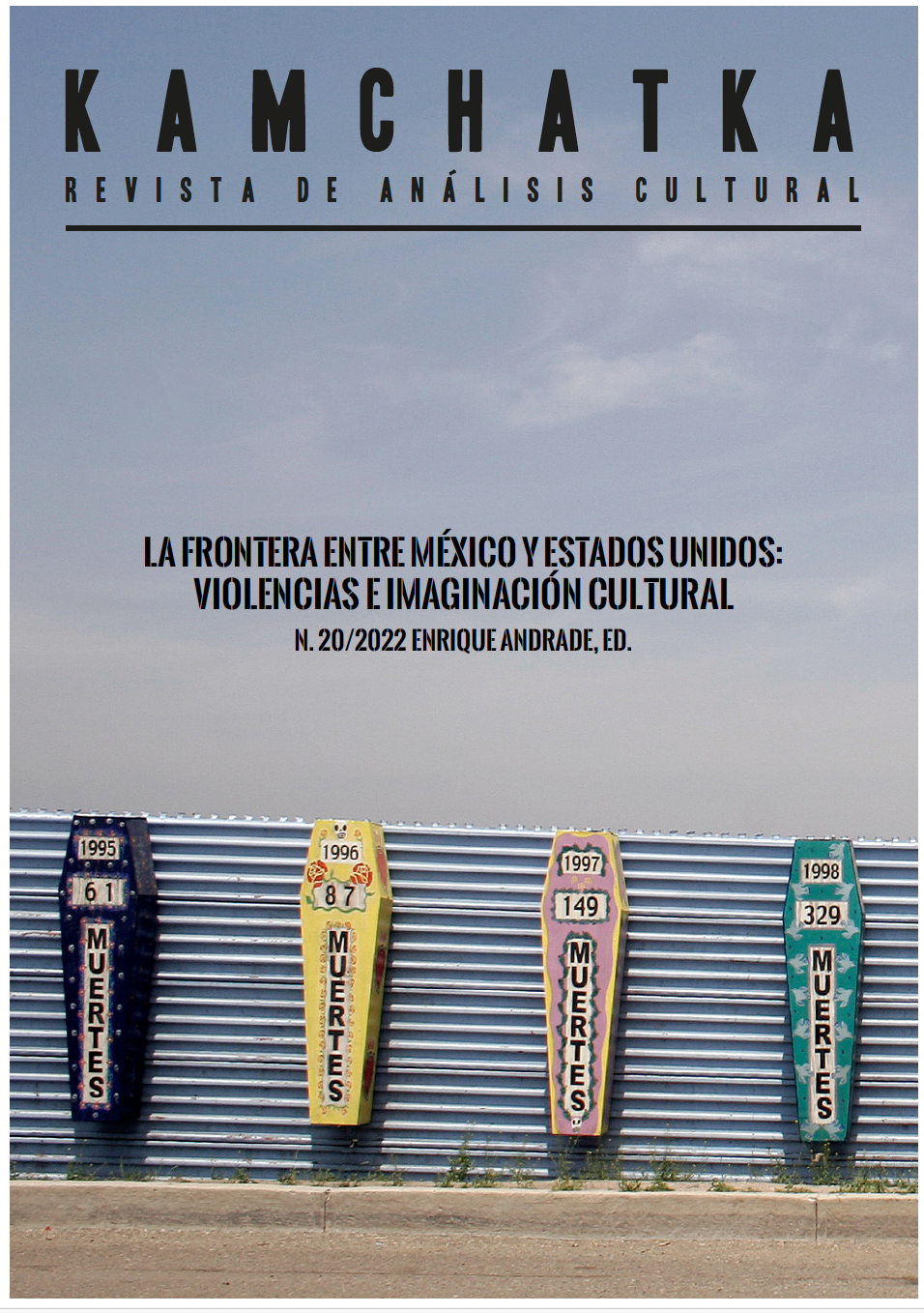Migration and Border: A Circular Topography of Border Violence. Insight into the artistic work of Cristian Pineda
DOI:
https://doi.org/10.7203/KAM.20.22129Keywords:
migration, art, violence, borders, exhibition, collective memory, Mexico Abstract
Abstract
The paper explores the artistic work of Cristian Pineda and wants to lead the reader to the migratory trails of the Mexican borders. To this end, the article confronts the situation of violence that affects the country’s borders. Considering this violence as generalized and generalizable cycles, the text approaches a dialogue between art and migration, borders and violence, memory and justice. The purpose of the reading is to understand how art can be an alternative to numbers, statistics and institutional discourses to talk about borders and migrants. For this, the article exposes the process of creation of the artwork as well as its exhibition to the public and the social interactions that this provokes. The final objective is to understand how art can assume a social and political position in the context of border violence in northern Mexico, particularly in the Arizona desert.
 Downloads
Downloads
 References
References
Arcos-Palma, Ricardo. “La Estética y su dimensión política según Jacques Rancière”. Nomadas 31 (2009): 139-155.
Bataillon, Gilles (2015), Narcotráfico y corrupción las formas de la violencia en México en el siglo XXI, Nueva sociedad 25 (2015): 554-68.
Biset Sébastien (2009), Dépolitisation de l’art et pratiques de responsabilisation: quand le désengagement artistique appelle la tactique de l’usage, Marges, revue d’art contemporain 9.
Bourriaud, Nicolas (2002). Esthétique relationnelle. Dijon : Ed. Les presses du réel. Bourriaud, Nicolas (2009). Formes de Vie, L’art moderne et l’invention de soi. París: Ed. Denoel.
Cajas, Juan (2013). "La frontera norte: cartografía de un modelo para armar''. Fronteras culturales, alteridad y violencia. El Colegio de la Frontera Norte. México: El Colegio de la Frontera Norte: 75-96.
Castillo, Manuel-Angel, Toussaint, Mónica. “La frontera sur de México: orígenes y desarrollo de la migración centroamericana”. Revista Cuadernos Inter.c.a.mbio sobre Centroamérica y el Caribe 12 (2015): 59-86.
Casillas, Rodolfo (2011). Los migrantes indocumentados: su vulnerabilidad y la nuestra. Armijo Canto, Natalia (ed.). Migración y seguridad: nuevo desafío en México. México: CASEDE A. C.:145-164.
Cervantes Porrúa, Israel. “El drama de Felipe Calderón en la guerra en contra del narcotráfico". Andamios Revista de Investigación Social 14(2017): 305-328.
Duchesneau, Catherine. “De la participation en art. L’Écomusée du fier monde comme alliance entre l’art et la participation citoyenne’’. Émulation, Art, participation et démocratie 9 (2011): 57-68.
Dieguez Caballero, Ileana. ''Encarnaciones poéticas. Cuerpo, arte y necropolítica''. Athenea Digital 18 (2018): 203-219. Fazio, Carlos (2016). Estado de emergencia. México: Grijalbo.
Fraser, Nancy (2005). Qu’est-ce que la justice sociale ? Reconnaissance et redistribution. Paris: La Découverte. Ferrarese, Esthère. ''Qu’est-ce qu’une lutte pour la reconnaissance ? : Réflexions sur l’antagonisme dans les théories contemporaines de la reconnaissance''. Politique et Sociétés 283 (2009): 101–116.
Galtung, Johan (1996). Peace by peaceful means. Peace and conflict, development and civilization. London: Sage.
Gatti, Gabriel. “Tiene [la] palabra la víctima pura [?] El vacío social, el testimonio y la desesperación del investigador ante el sufrimiento sin forma ni lenguaje”. Kamchatcka. Revista de Análisis Cultural 6 (2015): 801-815.
Lévinas, Emmanuel (1987). Humanisme de l’autre homme. Paris: Le Livre de Poche. Lévinas, Emmanuel (1990). Autrement qu’être ou Au-delà de l’essence. Paris: Le Livre de Poch.
Linares, Jorge. “Prácticas del activismo artístico en el Movimiento por la paz con Justicia y Dignidad. Resultado de investigación”. GT32, sociología del arte y de la cultura (2016).
Meyer, Lorenzo (2016). Distopía mexicana. Perspectivas para una nueva transición. Ciudad de México: Ed.Debate.
Nouss, Alexis (2015). La condition de l’exilé - Penser les migrations contemporaines. Paris: Ed. De la Maison des Sciences de l’Homme. Pourtois, Hervé. “La Reconnaissance : Une Question De Justice ?”. Politique et Sociétés 28(2009): 161.
Prévost, Natacha (2012). ''La révolution silencieuse des guerrières et guerriers du mouvement hip hop culturel du Brésil''. Corten, André, Huarth, Catherine y Peñafiel Ricardo (ed. ). Interprellation plébéienne en Amérique latine. Qébec: Karthala: 167-184.
Reguillo, Rosana. ''De las violencias: caligrafía y gramática del horror''. Desacatos, Revista de Ciencias Sociales 40 (2012).
Shank, Micheal y Schirch, Lisa. “Strategic Arts-Based Peacebuilding, Peace & Change”. Peace & Change-Journal of peace research 33 (2008): 217-242.
Suárez Ávila, Paola. ‘‘Arte y cultura en la frontera. Consideraciones teóricas sobre procesos culturales recientes en Tijuana’’. Anuario de Historia 1 (2007): 29-43.
Tienda Reyes, Oscar (2013). Fronteras culturales, alteridad y violencia. Tijuana: El Colegio de la Frontera Norte. Varela Huerta, Amarela. ''Las masacres de migrantes en San Fernando y Cadereyta: dos ejemplos de gubernamentalidad necropolítica''. Iconos. Revista de Ciencias Sociales 58 (2017): 131-149.
Zask, Joëlle (2018). ''Participer, Tour d’Enfance '' Bordeaux, https://www.academia.edu/37950981/ Participer_2018_.
Zelizer, Craig (2003). “The Role of Artistic Processes in Peace-Building in Bosnia-Herzegovina”. Peace and Conflict Studies 10 (2013): 62-75.
Downloads
Published
How to Cite
-
Abstract620
-
Artículo PDF (Español)340
Issue
Section
License
This journal provides an immediate free access to the content on the principle that freely make investigation available to the public, which promotes an increased global knowledge exchange.
Unless otherwise indicated, texts published in this journal are under the license Attribution-NonComercial 4.0 by Creative Commons. These texts may be copied, distributed and publicly communicated whenever the publication’s author and title are quoted and whenever they are not used for commercial purposes. In any case, intellectual property of the articles and its potential economic rights entirely belong to its authors.
The full license can be consulted on https://creativecommons.org/licenses/by-nc/4.0/. We encourage authors to disseminate papers published in Kamchatka. Journal of cultural analysis electronically, in institutional digital repository or in their websites.





